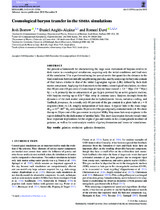| dc.contributor.author | Dave, Romeel | |
| dc.contributor.author | Borrow, Josh | |
| dc.contributor.author | Angles-Alcazar, Daniel | |
| dc.date.accessioned | 2021-02-12T09:38:23Z | |
| dc.date.available | 2021-02-12T09:38:23Z | |
| dc.date.issued | 2019 | |
| dc.identifier.citation | Dave, R. et al. (2019). Cosmological baryon transfer in the SIMBA simulations. Monthly Notices of the Royal Astronomical Society, 491(4), 6102–6119 | en_US |
| dc.identifier.issn | 1365-2966 | |
| dc.identifier.uri | https://doi.org/10.1093/mnras/stz3428 | |
| dc.identifier.uri | http://hdl.handle.net/10566/5911 | |
| dc.description.abstract | We present a framework for characterizing the large-scale movement of baryons relative to dark matter in cosmological simulations, requiring only the initial conditions and final state of the simulation. This is performed using the spread metric that quantifies the distance in the final conditions between initially neighbouring particles, and by analysing the baryonic content of final haloes relative to that of the initial Lagrangian regions (LRs) defined by their dark matter component. Applying this framework to the SIMBA cosmological simulations, we show that 40 per cent (10 per cent) of cosmological baryons have moved >1h−1Mpc (3h−1Mpc) by z = 0, primarily due to entrainment of gas by jets powered by an active galactic nucleus, with baryons moving up to 12h−1Mpc away in extreme cases. Baryons decouple from the dynamics of the dark matter component due to hydrodynamic forces, radiative cooling, and feedback processes. | en_US |
| dc.language.iso | en | en_US |
| dc.publisher | Oxford University Press | en_US |
| dc.subject | SIMBA simulations | en_US |
| dc.subject | Cosmological baryon | en_US |
| dc.subject | Galaxies: evolution | en_US |
| dc.subject | Galaxies: formation | en_US |
| dc.title | Cosmological baryon transfer in the SIMBA simulations | en_US |
| dc.type | Article | en_US |

